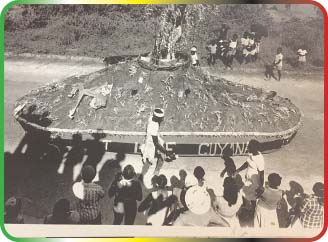Looking back at the years of Mashramani celebrations, a festival with its origin in the bauxite mining town of Linden, Region 10 (Upper Demerara-Berbice), one would note that it has undergone many unique and interesting transformations. This year marks 51 years of Guyana becoming a Republic. 
The Mashramani celebration started when the Junior Chamber – Jaycees – of Mackenzie (a community that now constitutes part of Linden), which had been organising the country’s Independence celebrations since 1966, sought to have a “carnival-like” festival to commemorate British Guiana gaining its Republican status in 1970. Chaired by popular West Indies cricketer Basil Butcher, the Jaycees Republic Committee was formed. It included members such as Jim Blackman, who was named Deputy to complete the task owing to Butcher being selected to the WI team about to tour Australia; resource personnel Adrian Thompson; Wordsworth McAndrew and Arthur Seymour.
Following the formation of the Committee, its members then began consultations so that a relevant name could be chosen for the festival, which was intended to celebrate the much-anticipated “Birth of the Republic.” It was Butcher, who then made the suggestion that an Amerindian or Indigenous name would be best suited. After the members of the Committee agreed, they contacted several Amerindians, including Allan Fiedtkou, an employee attached to the Geological Department of the then bauxite company, Demba. Fiedtkou suggested a name that he learnt from his grandfather that was used by Amerindians when they gathered to commemorate an auspicious event. As Fiedtkou explained, the celebration would last over several days, sometimes even up to a week. The men would go hunting and the women and children would gather materials to make a benab. Refreshments would be made and a feast would ensue. According to Fiedtkou, the term for the celebration sounded like “Muster Many” or “Mashirimehi”, and it sounded like “Mashramani” in Arawak. Subsequent research was unable to confirm it and after several authorities were consulted, the Committee went ahead with the term. Mashramani became known as an Amerindian term for celebration after hard work or a cooperative effort or the celebration after a job well done. As such, the Committee decided to call the festival Mashramani, with the aim of hosting a national observance. As such, on February 23, 1970, Guyana’s first Republican festival was staged at Linden.
The Jaycees, then headed by Jimmy Hamilton, had appointed the team to successfully organise the celebration, which was deemed a successful one. It featured three exciting days of competition and fun, attracting huge crowds from across the other administrative regions. The celebration eventually managed to secure sponsorship from Demerara Distillers Limited (DDL). Guyanese were said to have welcomed the observances with as much splendour as they welcomed the status of becoming an independent nation. There were activities such as “the Revolt dance”, a jouvert-like observance which became known as “Fo Day Mawnin Jump Up”; the Cde Mashramani contest; a calypso contest called the “Shanto” contest; a steel band contest and an extravagant float parade. Pageantry, in those days, was also a main attraction of the event, with the first winner of the Mashramani contest in 1970 being Hazel Figueira of Mackenzie, Linden.
In 1971, then Home Affairs Minister David Singh declared the celebrations in Linden open and decided that he would take a proposal to Cabinet to make the celebration a national one. With the assistance of the Jaycees Committee, the Minister travelled across the country to inform residents of the celebration. Since then, various activities were shifted to various areas across Guyana.
Enjoyed by many, Mashramani’s popularity quickly grew as it became a national observance. In 1972, it was taken to the capital city, Georgetown, following Singh’s intervention and then President Forbes Burnham granting permission. That year, the bauxite company in Linden sent a 500-strong contingent to Georgetown to participate in the parade. The move also saw the event being held in Linden, Berbice and Georgetown, but Linden failed to garner much sponsorship to sustain the costume and float parade.
Eventually, it was centred in Georgetown and as the years went by, other areas across Guyana joined in. Throughout the decades, the celebrations have evolved. As a witness to the celebrations in those days recalled, it was somewhat different from the “bacchanal-style” prancing down the streets these days.
Each year, thousands line the streets, with hundreds participating in the annual float parade held in Georgetown. The parade is usually an annual competition, with big bands participating. Additionally, many new activities have been incorporated into the celebrations, including the children’s costume competition, the junior and senior calypso and chutney competitions, chutney dance competition, duck curry competition, folk evening observance, bands concert and national art exhibition.
Traditional activities have remained, including the steel band concert and panorama as well as masquerade jamboree. However, many long for the return of the Mashramani pageant, which was hosted back in those days. While a few pageants were hosted over the years, it has not been on the annual calendar of events.
As for the community of Linden where it all started, the celebration was held approximately a week after the grand float parade in Georgetown. Costumes were usually sponsored by the Regional Democratic Council (RDC) and a few businesses. However, the float parade in the mining town can be considered miniature to that of the capital city.
Over the years, Lindeners have longed to see the return of the celebration to the town.
This year, Mashramani is being celebrated virtually because of COVID-19.
